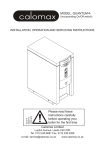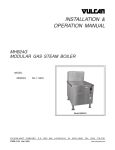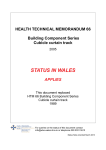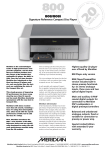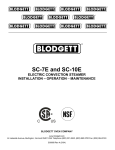Download quantum full manual issue 3.indd
Transcript
Quantum Counter-top Catering Water Boiler INSTALLATION, OPERATION AND MAINTENANCE MANUAL Read these instructions thoroughly before commencing installation or undertaking maintenance work. TEL: 0113 249 6681 FAX: 0113 235 0358 Issue 3 - DCR 674:8/6/05 www.calomax.co.uk CONTENTS 1. PARTS IDENTIFICATION . . . . . . . PAGE 1 2. PLANNING THE INSTALLATION . . . . . . . 2 2.1 Water Requirements . . . . . . . 2 2.2 Electrical Requirements . . . . . . . 2 2.3 Installation Location . . . . . . . 2 2.4 Vent/Overflow Pipe Requirements . . . . . 2 3. INSTALLATION . . . . . . . . . 3 4. COMMISSIONING . . . . . . . . . 3 5. USER INSTRUCTIONS . . . . . . . . 3 5.1 Cleaning . . . . . . . . 4 5.2 Service Indicator Light . . . . . . . 4 . . . . . . . 4 6.1 Draining Down The Boiler . . . . . . . 4 6.2 Scale . . . . . . . 4 6.2.1 Checking the Extent of Scale Formation . . . . . 4 6.2.2 De-Scaling . . . . . 4 . . . . . 5 6.4 Replacing the Main Printed Circuit Board and Triac PCB. . . . 5 6.5 Replacing the Inlet Solenoid Valve . . 5 6.6 Replacing the Dispense Valve, Key Switch, Push Button, Fascia PCB . 5 6.7 Adjusting the Water Temperature Set Point . . . . . 6 7. FAULT FINDING 8. WIRING SCHEMATIC 6. MAINTENANCE . . . . . . . . . . 6.3 Replacing the Element or Thermistor . . . . . . . . . . . . . 6 . . . . . . . . 7 ISSUE 3 QNS nozzle sheath KSK keyswitch PBK push button FIH Water Research Council approved hose PAGE 1 CASSV solenoid valve QEDV drain valve QTK front trim panel QDVK valve including silicone sealing grommet QPCBT main pcb includes triac pcb QAPCBT auxiliary pcb NB15BLG body lid gasket CASLPK kit comprising 3 off level sensors NBPRG pressure relief grommet QOCL lid NBE3HK element (Wrapper not shown for clarity) TAK thermistor assembly kit CASMR manual reset thermostat 2. PLANNING THE INSTALLATION All installation and maintenance work must be carried out by competent persons. 2.1 Water Requirements The unit is designed to be connected to a cold water rising mains supply, using 15mm table “X” copper tube with a minimum pressure of 20 KPa (0.2bar) and a maximum pressure of 1000 KPa and (10 bar). So as to comply with the U.K. Water Bylaws a single check valve must be fitted to the cold water mains supplying the boiler. It is also recommended that an isolating valve be fitted to the mains water supply to the boiler to facilitate maintenance. 2.3 Installation Location Ensure the counter top is of suitable construction to support the working weight of the boiler. See Fig. 1 To comply with recommendations from the health and safety executive it is important that due consideration be given to the safe operation of the controls of the boiler. The boiler should therefore be mounted in such a manner that the operator can stand directly facing the machine with the controls at the recommended height. See fig 2 Consideration should also be given to the servicing requirements of the machine. Fig 2 1200.47 The formation of scale in hard water areas is a problem associated with all hot water appliances. Damage to the boiler caused by excessive scale deposits is not covered by the manufacturer’s warranty. The height from the floor to the dispense valve should be 1200mm +/- 100mm 2.2 Electrical Requirements The installation must comply with the current I.E.E Wiring regulations, if in doubt consult a qualified electrician. This appliance must be earthed. The boiler complies with the Electrical Equipment Safety Regulations (SI1994/3260) and has been independently tested to BS EN60335-2-63. The boiler operates a nominal 3 kW element at 240v. 50Hz supply. A circuit diagram is provided at the back of the manual 2.4 Vent / Overflow Pipe Requirements The vent and overflow pipe should be extended on site using 15mm Speed-fit plastic tube or 15mm Table “X” copper tube. The pipe must be laid with a continuous fall, discharging to a safe and visible position. The vent and overflow pipe should not be connected directly to a soil pipe and should never be allowed to become blocked or restricted. See fig 3 VENT / OVERFLOW FITTED WITH PUSH-ON SILICONE HOSE FOR EASE OF MAINTENANCE Fig 1 410 240 DRY WEIGHT 12kg WORKING WEIGHT 29Kg ISSUE 3 65 140 190 85 470 535 85 45 SOLENOID WATER INLET CONNECTION PAGE 2 3. INSTALLATION 1. The boiler is supplied with a 3/4” BSP Water Research Council approved flexible water connection hose. This hose should be connected to the mains water supply using an isolating valve and then fitted to the machine solenoid valve inlet. 2. The vent / overflow pipe should be extended on site using 15mm Table X copper tube or ‘Speedfit ‘ plastic pipe as described in Fig 3. The overflow pipe must be fitted and arranged such that the outlet position is safe, visible and external to the boiler. The overflow pipe must not be connected directly to a soil pipe and should never be allowed to become blocked or restricted. 3. All Quantum machines are pre-wired with a 13A plug and lead for use with a 13 A socket. Boiler Vent / Overflow connection Fig 3 Vent and Overflow pipe 8 Trapped water prevents boiler breathing Incorrect Silicone connecting hose Vent and Overflow Connect pipes using silicone tube provided 9 Pipe-work should be fitted with a continuous fall to a safe and visible point of discharge (e.g. a sink). It should not be connected directly to a waste system because taste and smell problems will occur. Correct With the key switch in the ‘ON’ position the push button will stop flashing and show solid colour when the boiler is up to full temperature and the button will be enabled, at this point the ‘ Ready’ light will stop flashing and show solid colour and the ‘Full’ light will also be illuminated. On subsequent operation of the boiler The boiler will fill and heat in cycles. It will allow only a limited amount of water to enter the unit at any one time and then switch off the solenoid and energise the element. 5. USER INSTRUCTIONS Boiling water is dispensed by operating the push button. The button will only be useable when the key switch is in the ‘ON’ position and illuminated solid green colour, indicating that water is up to temperature. Due caution should be applied as the water is at approximately 98˚ Centigrade at all times. The ‘Ready’ light will flash when the boiler is not up to temperature and show solid colour when at operating temperature. The ‘Full’ light will illuminate only when the boiler is at operating temperature and also full capacity is available for dispense. If all water is drawn from the unit the flow will reduce to a trickle. The unit will replenish the supply in cycles i.e. a small amount of water will enter the unit , which will subsequently be heated but all water available will be at approximately 98 ˚ Centigrade. Figure 4 shows the approximate times for boiling water to be available from switch on. Fig 4 Air gap This installation allows the silicone hose to fit loose inside a fixed fitting. Air is allowed into the boiler at this point and will allow the boiler to breath in the event of the overflow becoming trapped. 9 Correct Pipe-work should be fitted with a continuous fall to a safe and visible point of discharge (e.g. a sink). It should not be connected directly to a waste system because taste and smell problems will occur. From empty After overnight stand (full) Full capacity available after 45 mins 17 mins 4. COMMISSIONING 1. Turn water supply on 2. Turn electrical supply on On initial switch-on only After a few seconds delay for the electronics to charge up, the boiler will begin filling with water and the ‘Ready’ light will flash to indicate wait. If the key switch is in the ‘on’ position the push button will flash green to indicate wait, at this point the button is disabled. When water reaches the low level sensor (element covered) the element will be energised as well as the solenoid. When normal operating level is reached the solenoid will turn off and the element will remain on until full operating temperature is reached. ISSUE 3 PAGE 3 5.1 Cleaning When required the unit should be wiped down with a damp cleaning cloth The unit is not protected against the ingress of water and therefore should not be washed down in any manner that would allow water to enter the electrical chamber of the unit e.g. the use of a spray water jet. 5.2 Service light Certain types of operational fault will cause the ‘Service’ light to flash. If this occurs refer to the section ‘Fault Finding’ on page 6. 6. MAINTENANCE Competent persons must carry out all maintenance work. When the body lid has been removed, it is recommended that a new body lid gasket is fitted on assembly to ensure a steam tight seal. Damage to the unit caused by incorrectly sealed gaskets that should have been replaced during maintenance is not covered by the manufacturers warranty. To ensure regular trouble free operation, periodically check for scale inside the boiling chamber and around the dispense valve, see section 6.5 on page 5. The production of scale is a natural phenomenon and some de-scaling may be required within the first 12 months. This is not covered under the products warranty as it is not a fault. The solenoid is fitted with a removable filter at the inlet point. This filter should be cleaned as required. Check the extent of scale formation on the element. 6.2.1 Checking the extent of scale formation 1. Remove the body lid by releasing the four fixing screws. To remove the lid it must be pushed forwards to the front of the boiler before lifting to allow the condenser mechanism to clear the body top flange. See Fig. 5 Fig. 5 6.1 Draining down the boiler For ease of maintenance the Quantum water boiler is fitted with a drain valve at the rear of the unit The machine should be manoeuvred over a sink or large vessel that will adequately take the volume of water from the machine. To guard against a dripping drain valve, a blanking cap is fitted at the outlet of the valve and must be removed prior to draining the unit and replaced after the valve has been turned off. 6.2 Scale The Quantum boiler incorporates an integral scale inhibitor. In general, independent users throughout the country have benefited from either a vastly reduced scale build up, and / or much easier maintenance due to the softer nature of the scale, which tends not to adhere rigidly to the internals of the machine. Please note that this is not a scale eliminator and its effect will differ according to water quality. ISSUE3 It is very important that the lid assembly is fitted the correct way round for the condenser to work effectively. See label on top of lid IMPORTANT. It is recommended that a new body lid gasket be fitted on re-assembly to ensure a steam tight seal. Damage to the unit caused by incorrectly sealed gaskets that should have been replaced during maintenance is not covered by the manufacturers warranty. 6.2.2 De-Scaling Scale deposits should be removed from all internal surfaces, particularly the heating element, thermistor pocket and level sensor probes. Gentle tapping or scraping is usually sufficient to remove scale build up. If the deposits are soft use a nylon pad and flush out with water. Abrasive cleaning materials containing scouring powder and detergents must not be used, such materials can cause taste problems. Chemical de-scalants must only be used in accordance with the manufacturers instructions. IMPORTANT. All chemical agents must be thoroughly flushed out to avoid taste problems, health risks, and possible malfunction of the boiler. PAGE 4 Before re-commissioning the unit, all scale and moisture must be removed from the level sensor insulating gaskets to avoid false signalling through the scale to the boiler body. Failure to remove this scale and dry the probes could cause the sensor to indicate to the Printed Circuit Board (PCB) that water is covering the element whether or not water is present. In this situation the PCB could energise the element , causing failure. If in doubt , protect the element by hand filling the boiler with water to cover the element before switching on the electrical supply. 6.3 Replacing the Element or Thermistor The element or thermistor can be replaced by removing the back-nuts and washers and withdrawing from inside the boiling chamber. IMPORTANT : A new body lid gasket may be required. 6.4 Replacing the Main Circuit board (PCB) and Triac PCB. The main PCB and the triac PCB should be replaced as a matched pair to be sure of correcting circuit board faults. 1. Disconnect the wiring connections to the main PCB 2. Remove the PCB by pulling it forward off the supports 3. Disconnect the wiring to the triac PCB and remove by releasing the fixing screw and pulling it forward off the supports. 4. Apply a thin layer of heat transfer compound (supplied) to the mounting platform of the replacement triac PCB and fit to the mounting supports. Ensure it is positively located and secure it with the single fixing screw. 5. Reconnect the triac wiring , see wiring diagram at the rear of the manual 6. Position the main PCB on the four supports and wire in accordance with wiring diagram 6.5 Replacing the Inlet Solenoid Valve IMPORTANT: In areas where scale can be a problem, check that the fault is not due to a blocked filter ( this is removable at the inlet to the solenoid) before replacing the unit. Scale build up in the filter can cause intermittent problems. 1. Remove the silicone hose that joins the solenoid to the water inlet. Warning, the pipe will retain a volume of water that will be released when the connection is broken. ISSUE 3 2. Pull the solenoid from the mounting bracket IMPORTANT: the correct operation of the boiler relies on a regulated flow of water from the solenoid valve and therefore a genuine replacement part supplied by Calomax must be fitted. 3. Fit the replacement part onto the existing mounting bracket (if a mounting bracket was supplied with the replacement valve this should be removed ) and re-connect the live and neutral connections 6.6 Replacing the Dispense Valve, Key Switch , Push Button, Fascia PCB To replace any of the above parts, the following instructions should be followed:1. Remove the outer casing lid 2. Loosen the two screws in the cover plate located above the fascia and slide the plate out. 3. Remove the four screws from the back panel and remove , being careful not to damage the thermal cut-out in the process 4. Remove each of the two screws holding the copper heat sink, solenoid bracket and main PCB bracket in position and allow them to hang loose. 5. Remove the earth wire adjacent to the main PCB from the right hand side of the outer casing. 6. Unplug the wiring harness from the fascia PCB and move the harness away from the top of the outer casing. 7. Remove 2 screws from either side of the base of the boiler. 8. The outer casing can now be removed by leaning it forward, clear of the dispense valve, and lifting it up / forward from the base. Note : when re-assembling the boiler ensure the wiring harness is plugged back into the fascia PCB and the harness does not become trapped between the body and outer casing. Dispense Valve 1. Disconnect the wires from the coil 2. Remove the two setscrews 3. Pull the valve forward leaving the rubber insert behind. PAGE 5 Cleaning the Dispense Nozzle 1. Slide the retaining clip out from the flow restrictor housing. 2. Remove the breather hose. 3. Quarter turn the flow restrictor / nozzle housing and pull free, clean and re-assemble Key Switch 1. Disconnect the 2 wires from the fascia PCB 2. Remove the single retaining screw from the centre of the switch 3. Slide the retaining collar away from the switch and withdraw the switch from the boiler. 4. Fit the new switch ensuring it is the correct way up so as to correspond with the lock / unlock symbols on the front of the boiler. Note : Take care not to over tighten the retaining screw when assembling Push Button Switch 1. Disconnect the 4 wires from the fascia PCB 2. Using the tool provided, unscrew the retaining collar anti-clockwise and withdraw the push button switch. 3. Fit the new switch and re-wire. Refer to the wiring diagram at the rear of the manual. Fascia PCB 1. Disconnect the 6 wires from the fascia PCB 2. Remove the retaining screws and gently pull away from the lens housing 3. Fit new PCB and re-wire. Refer to the wiring diagram at the rear of the manual 6.7 Adjusting the Water Temperature Set Point The temperature potentiometer (Pot) is pre-set at Calomax and will only require adjustment in exceptional circumstances, the adjustment Pot is located at the bottom left corner of the main PCB. It controls the operating temperature of the boiler. 1/2 turn clockwise on the device will raise the temperature of the water by approximately 1 degree centigrade. ISSUE 3 Water boils at different temperatures depending on barometric pressure. The temperature should not be tuned higher than the pre-set 98 degrees, or over boiling may occur, causing the unit to trip the over heat cut-out device. 7. FAULT FINDING To protect the unit in the event of continuous over boiling, the unit is fitted with a thermal cut-out device. This device will cut power to the entire machine and can be re-set manually. Before re-setting the device, the cause of the trip (de-scale required etc.) should be investigated. The ‘Service’ light on the front of the machine and Light Emitting Diodes (LED’s) fitted to the main PCB, can be used to diagnose operating problems with the machine. When the green ‘service’ light is showing solid colour, the machine has been starved of water and has disabled the solenoid to protect against burn out. In this state the boiler must be disconnected from the power supply and then switched back on to re-enable the solenoid after the water supply has been re-established Certain types of operational fault will cause the ‘service’ light to flash in a sequence of pulses A two pulse generally indicates that the low level probe requires de-scale A three pulse indicates a loss of signal from the normal water level probe , causing the unit to overfill. A four pulse indicates the unit has overfilled due to debris trapped in the solenoid valve. This is usually solved by drawing all the water from the machine, causing the valve to operate and flush out the obstruction. Check for debris in the valves inlet filter. A five pulse indicates the boiler has overfilled due to scale on both the low and normal water level probes. The unit can be used normally while the service light is flashing LED’s fitted to the main PCB indicate the operation of the solenoid and element. The red LED indicates the element should be energised and the yellow LED indicates the solenoid should be energised. The solenoid, dispense valve and element are permanently live fed, and each are switched via the neutral connection. PAGE 6 Wiring Schematic for Calomax Quantum Water Boiler using v10 board TRIAC PCB YELLOW / GREEN BLACK RED RED BLACK EARTH ON BASE EARTH ON BODY EARTH ON CASING E N L LEVEL SENSORS RED HIGH NORMAL THERMAL CUTOUT +12Vdc (BROWN) 0Vdc (ORANGE) ELEMENT LOW PINK BROWN ORANGE OPT1 RED CONNECTOR PLUG QPCBA U1 OP1 L N RED WHITE BLACK YELLOW / GREEN BLACK RED HOT WATER OUTLET DISPENSE VALVE YELLOW BLACK BLUE BROWN HEATER LED ORANGE SOLENOID LED BLACK BLACK COLD WATER INLET SOLENOID VALVE E BLUE 0.75mm YELLOW BLUE PINK ORANGE PINK BLUE RED YELLOW PUSH BUTTON ON FRONT PANEL 0.2mm YELLOW THERMISTOR KEYSWITCH ON FRONT PANEL Wiring Schematic for Calomax Quantum Water Boiler using v11 board TRIAC PCB YELLOW / GREEN BLACK RED RED BLACK EARTH ON BASE EARTH ON CASING EARTH ON BODY N E L LEVEL SENSORS RED HIGH NORMAL THERMAL CUTOUT +12Vdc (BROWN) 0Vdc (ORANGE) ELEMENT LOW PINK BROWN ORANGE BLACK RED OPT1 U1 E BLACK BLUE BROWN ORANGE BLACK HEATER LED BLACK BLUE N YELLOW BLUE RED YELLOW SOLENOID LED COLD WATER INLET SOLENOID VALVE BLUE QPCBA OP1 L RED WHITE CONNECTOR PLUG YELLOW / GREEN BLACK RED HOT WATER OUTLET DISPENSE VALVE 0.75mm YELLOW 0.2mm YELLOW PINK PINK ORANGE PUSH BUTTON ON FRONT PANEL KEYSWITCH ON FRONT PANEL ISSUE 3 THERMISTOR PAGE 7










